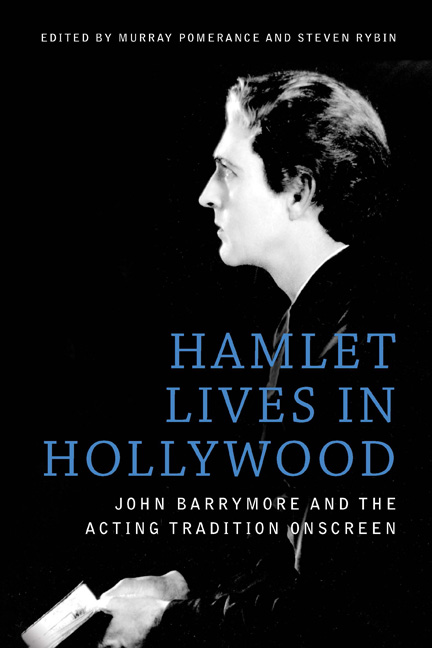Book contents
- Frontmatter
- Contents
- List of Figures
- The Contributors
- Acknowledgments
- Introduction
- 1 The Pre-Bard Stage Career of John Barrymore
- 2 Dangerously Modern: Shakespeare, Voice, and the “New Psychology” in John Barrymore's “Unstable” Characters
- 3 The Curious Case of Sherlock Holmes
- 4 John Barrymore's Introspective Performance in Beau Brummel
- 5 “Keep Back your Pity”: The Wounded Barrymore of The Sea Beast and Moby Dick
- 6 From Rome to Berlin: Barrymore as Romantic Lover
- 7 The Power of Stillness: John Barrymore's Performance in Svengali
- 8 Prospero Unbound: John Barrymore's Theatrical Transformations of Cinema Reality
- 9 A Star is Dead: Barrymore's Anti-Christian Metaperformance
- 10 Handling Time: The Passing of Tradition in A Bill of Divorcement
- 11 John Barrymore's Sparkling Topaze
- 12 “Planes, Motors, Schedules”: Night Flight and the Modernity of John Barrymore
- 13 Barrymore and the Scene of Acting: Gesture, Speech, and the Repression of Cinematic Performance
- 14 “I Never Thought I Should Sink So Low as to Become an Actor”: John Barrymore in Twentieth Century
- 15 Barrymore Does Barrymore: The Performing Self Triumphant in The Great Profile
- Works Cited
- Index
6 - From Rome to Berlin: Barrymore as Romantic Lover
Published online by Cambridge University Press: 23 June 2018
- Frontmatter
- Contents
- List of Figures
- The Contributors
- Acknowledgments
- Introduction
- 1 The Pre-Bard Stage Career of John Barrymore
- 2 Dangerously Modern: Shakespeare, Voice, and the “New Psychology” in John Barrymore's “Unstable” Characters
- 3 The Curious Case of Sherlock Holmes
- 4 John Barrymore's Introspective Performance in Beau Brummel
- 5 “Keep Back your Pity”: The Wounded Barrymore of The Sea Beast and Moby Dick
- 6 From Rome to Berlin: Barrymore as Romantic Lover
- 7 The Power of Stillness: John Barrymore's Performance in Svengali
- 8 Prospero Unbound: John Barrymore's Theatrical Transformations of Cinema Reality
- 9 A Star is Dead: Barrymore's Anti-Christian Metaperformance
- 10 Handling Time: The Passing of Tradition in A Bill of Divorcement
- 11 John Barrymore's Sparkling Topaze
- 12 “Planes, Motors, Schedules”: Night Flight and the Modernity of John Barrymore
- 13 Barrymore and the Scene of Acting: Gesture, Speech, and the Repression of Cinematic Performance
- 14 “I Never Thought I Should Sink So Low as to Become an Actor”: John Barrymore in Twentieth Century
- 15 Barrymore Does Barrymore: The Performing Self Triumphant in The Great Profile
- Works Cited
- Index
Summary
After his final performance of Hamlet in London in 1925, John Barrymore abruptly left the stage for films. His portrayal of the Danish prince had proven to be a huge success in New York as well as in London. But, upon returning from England to New York in 1925, Barrymore immediately left for Hollywood, enticed by money and what must have seemed to him the less strenuous demands of film acting. After all, Barrymore had given over a hundred performances of Hamlet, first in New York and then the following year in London. He might very well have been both physically and mentally exhausted. He had earlier starred in several silent films, one of which, Beau Brummel (1924), cast him as a dandy with a proclivity for seducing women. The film ends with the aged lover on his deathbed, visited by the one woman he had loved. With a romantically melodramatic flourish, the two die together in each others’ arms. The persona of the great onscreen romantic lover will carry over into four films he made from 1926 to 1932: Don Juan (1926), Eternal Love (1929), Arsène Lupin (1932), and Grand Hotel (1932). In these films Barrymore proved himself adept at playing a host of onscreen lovers: a psychologically damaged lothario; an overly passionate outsider; a stylish thief; and an insolvent aristocrat reduced to gambling and burglary. Ostensibly, these roles and their contexts differ from one another but they are linked not only by Barrymore the actor but by a set of thematic approaches to romantic love.
DON JUAN
Barrymore's first film upon his return to Hollywood was an adaptation of Melville's Moby-Dick (The Sea Beast, 1925). Because of audience demand orperhaps because of Barrymore's own persona, a romantic subplot was added to the script. In his second film, Alan Crosland's Don Juan, Barrymore established himself more fully as a great onscreen lover. An attractive physique and acrobatic skills served him well in a film genre that had been established by the dashing Douglas Fairbanks in a series of costume dramas that included such successful projects as The Mark of Zorro (1920), Robin Hood (1922), and, in the same year Don Juan was released, The Black Pirate (1926).
- Type
- Chapter
- Information
- Hamlet Lives in HollywoodJohn Barrymore and the Acting Tradition Onscreen, pp. 71 - 84Publisher: Edinburgh University PressPrint publication year: 2017

